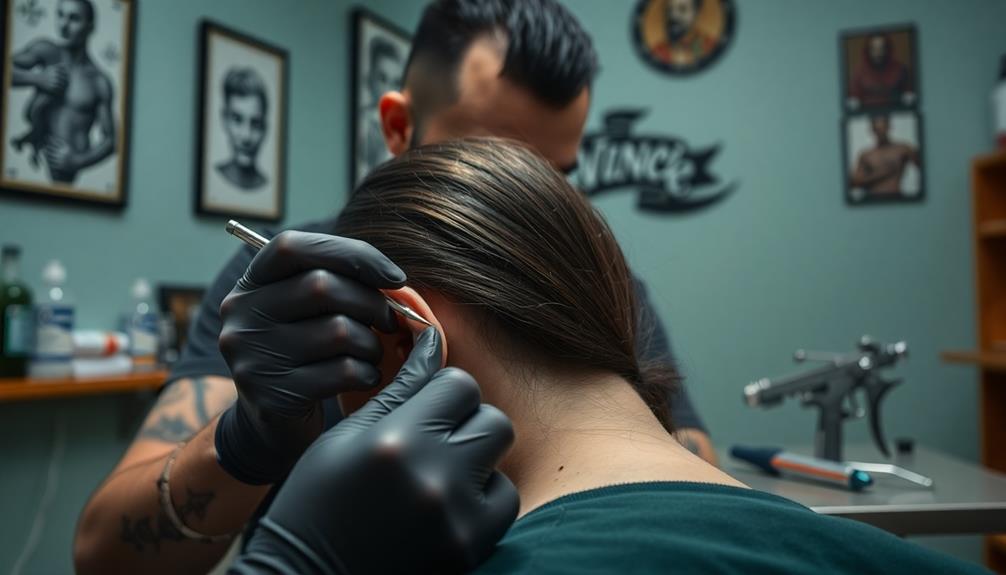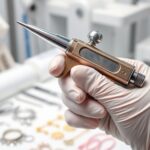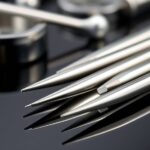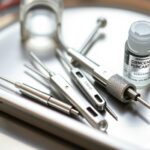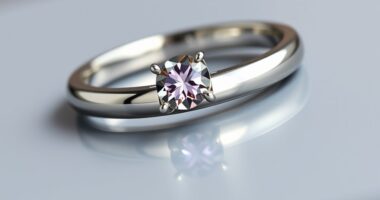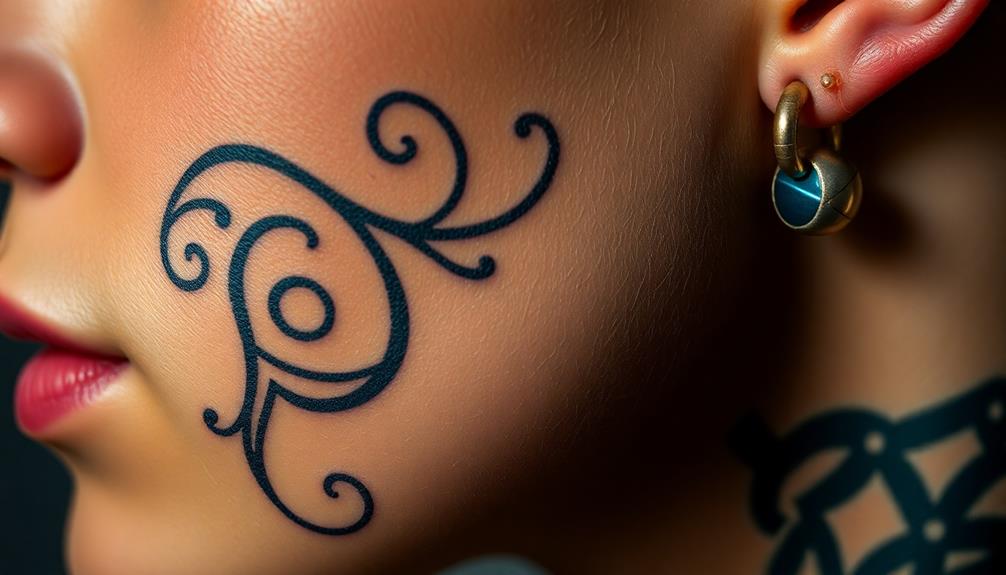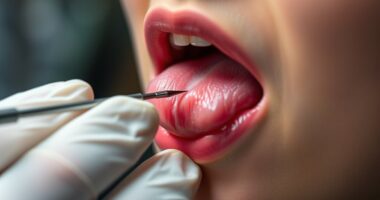Professionals prefer needles over piercing guns for several important reasons. Needles cause less tissue trauma, resulting in a cleaner incision that speeds up healing. You'll find that professional piercers use sterilized, single-use needles, ensuring maximum hygiene. Needles also allow for precision in placement, minimizing complications and discomfort. In contrast, piercing guns can create blunt force trauma, leading to longer healing times and uneven placements, especially in cartilage. With the right knowledge about the advantages of needle piercings, you'll enjoy a safer and more pleasant experience. Stick around to uncover more insights about the best options for body piercings!
Key Takeaways
- Professionals favor needles for their ability to create clean incisions, minimizing tissue trauma and reducing healing times compared to piercing guns.
- Extensive training for needle piercers enhances their expertise in anatomy and hygiene, ensuring safer practices than many gun practitioners.
- Needle piercings generally result in lower pain levels and discomfort, offering clients a more pleasant experience during and after the procedure.
- High-quality, implant-grade jewelry used by professional piercers reduces the risk of allergic reactions, unlike the often lower-quality jewelry provided by gun practitioners.
- Enhanced safety protocols, including single-use and pre-sterilized needles, significantly lower the risk of infection and complications compared to piercing guns.
Overview of Piercing Methods
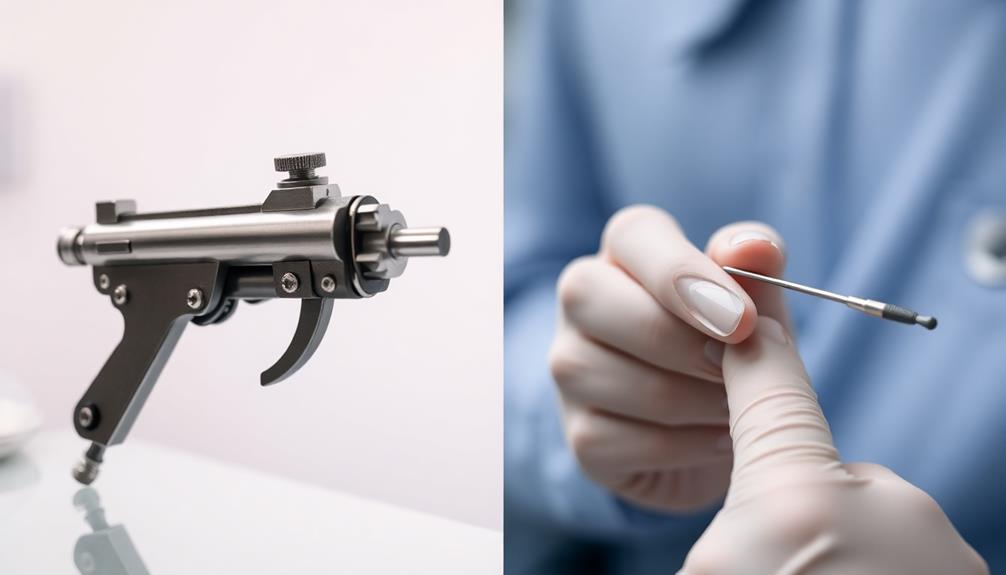
When choosing a method for body piercing, it's essential to understand the differences between piercing guns and needles.
Piercing needles, made of surgical-grade stainless steel or niobium, offer a sharp, hollow design that allows for precise placements with minimal tissue trauma. Unlike piercing guns, which utilize a blunt force mechanism to push jewelry through the skin, needles create a clean incision. This greatly reduces the risk of complications and shortens healing time.
Professional piercers favor single-use, sterilized needles to guarantee maximum hygiene and prevent cross-contamination. They know that using a needle minimizes the risk of infection, as it maintains a sterile environment during the piercing process.
Conversely, piercing guns are often linked to increased risks, such as improper sterilization and uneven placements, particularly in cartilage piercings, which can lead to more serious issues down the line.
Training and Professional Standards
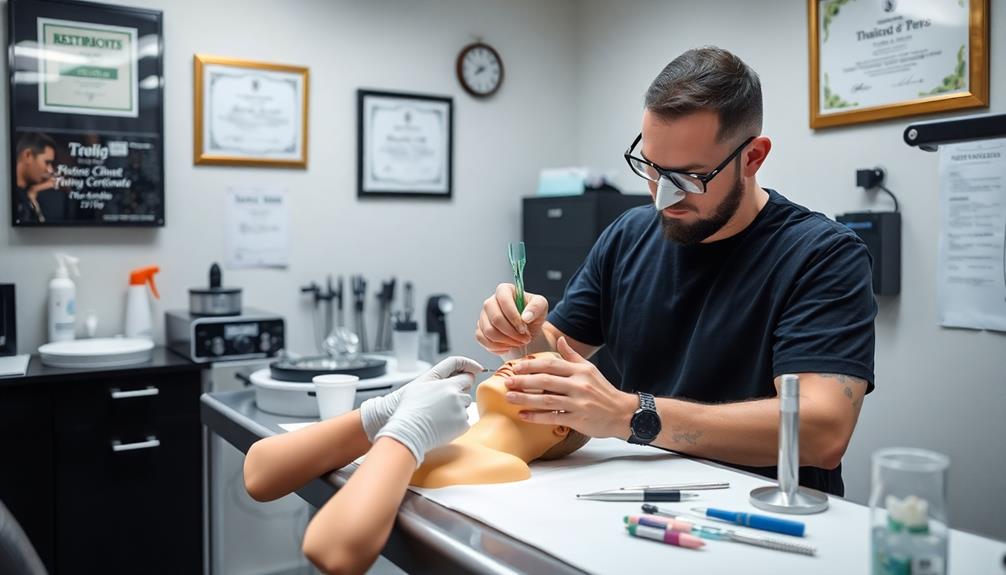
When considering body piercings, it's essential to understand the training requirements for piercers and the professional standards that guide their practice.
Unlike those using piercing guns, trained needle piercers invest significant time in learning anatomy and hygiene, which directly impacts the safety of your piercing.
Training Requirements for Piercers
Training requirements for piercers play a crucial role in ensuring safe and effective procedures. As you consider becoming a professional piercer, it's important to understand that extensive training is typically required, often lasting over a year. This training focuses on anatomy, hygiene, and safety protocols critical for the piercing process.
While some may use piercing guns, many of these practitioners lack adequate training, which can lead to unsafe practices and complications. In contrast, needle piercers learn proper sterilization techniques, minimizing infection risks while achieving precise placements.
Legitimate training programs offer hands-on experience under the supervision of experienced professionals, equipping you to handle various scenarios safely. The Association of Professional Piercers sets stringent standards for training and certification, promoting a higher level of expertise among those who use needles.
Importance of Professional Standards
Professional standards in the piercing industry are fundamental for guaranteeing safe and effective practices. When you choose a professional piercer, you're benefiting from their extensive training, which often lasts over a year. This training includes essential knowledge about anatomy, hygiene, and safety protocols.
The Association of Professional Piercers sets high standards for training and certification, emphasizing the need for skilled practitioners.
Many piercers using guns lack this level of training, which can lead to unsafe practices and poor outcomes. Without proper education, the risk of complications increases, jeopardizing your safety. In contrast, trained professionals who specialize in needles can achieve greater precision, reducing trauma to your body during the piercing process.
Moreover, professional standards guarantee that piercing establishments prioritize hygiene and safety, which is critical for preventing infections and other complications. This commitment to excellence often results in a preference for needle piercings over gun methods, as needles provide superior outcomes.
Ultimately, choosing a trained professional who adheres to industry standards protects your health and enhances your overall piercing experience.
Pain and Tissue Trauma
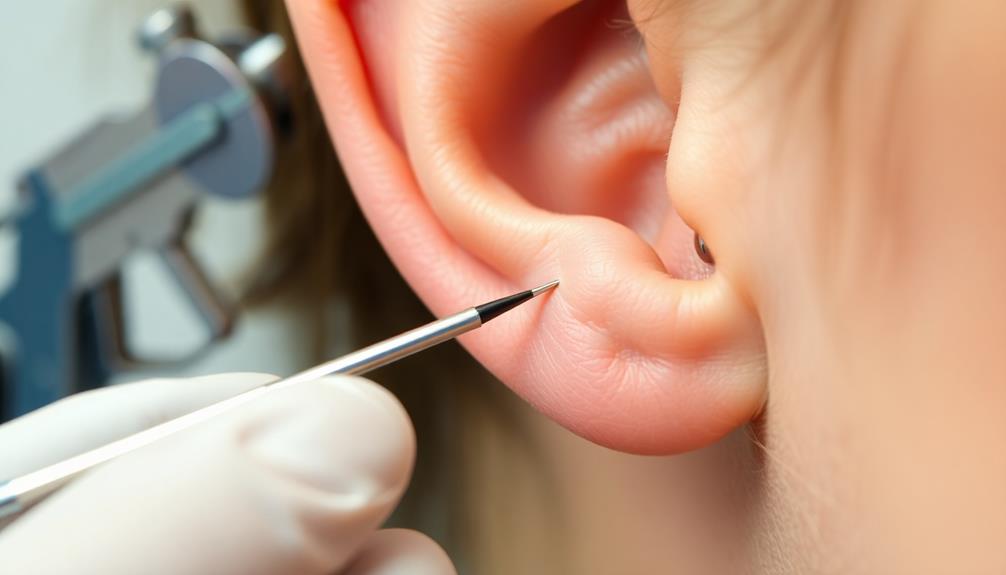
When considering pain and tissue trauma, you'll find that piercing guns often cause more discomfort than needle piercings.
The blunt force from a gun can lead to excessive tissue damage, resulting in greater pain and a longer healing time.
In contrast, needles create cleaner holes with less trauma, allowing for a smoother recovery.
Pain Comparison
Many people underestimate the pain involved in body piercings, but the method used can greatly affect your experience.
When considering pain comparison between piercing guns and needle piercings, you'll find that the latter is generally more comfortable. Piercing guns can't provide the same level of precision, resulting in more blunt force trauma and increased tissue trauma. This can lead to excessive bleeding and bruising, making the process feel more painful.
With needle piercing, you benefit from:
- Cleaner incisions that minimize discomfort
- Less tissue trauma, promoting a smoother healing process
- A more controlled and precise piercing experience
- Reports of lower pain levels during the procedure
Professional ear piercing practitioners emphasize that using needles creates smaller holes with reduced tissue damage, which not only leads to less pain but also guarantees faster healing.
Studies show that clients who choose needle piercings often report a more pleasant experience overall.
Tissue Trauma Impact
Understanding the impact of tissue trauma is essential when deciding between piercing methods. Piercing guns create more tissue damage since they use blunt force to push jewelry through the skin. This approach often results in excessive bleeding, bruising, and significant trauma.
In contrast, needle piercings involve a clean incision that minimizes damage to surrounding tissue, allowing for precise placement.
Studies show that with needle piercings, you typically experience lower pain levels during the procedure due to reduced tissue trauma. This is an important factor to take into account, especially if you're concerned about discomfort.
The increased trauma linked to piercing guns can lead to longer healing times, as damaged tissue takes more time to recover compared to the smaller, cleaner holes made by needles.
Moreover, professionals report that the cleaner incisions from needles not only reduce immediate pain but also lower the risk of complications and infections during the healing process.
If you want a smoother experience with less trauma and quicker healing, opting for needle piercings is the clear choice.
Precision and Accuracy
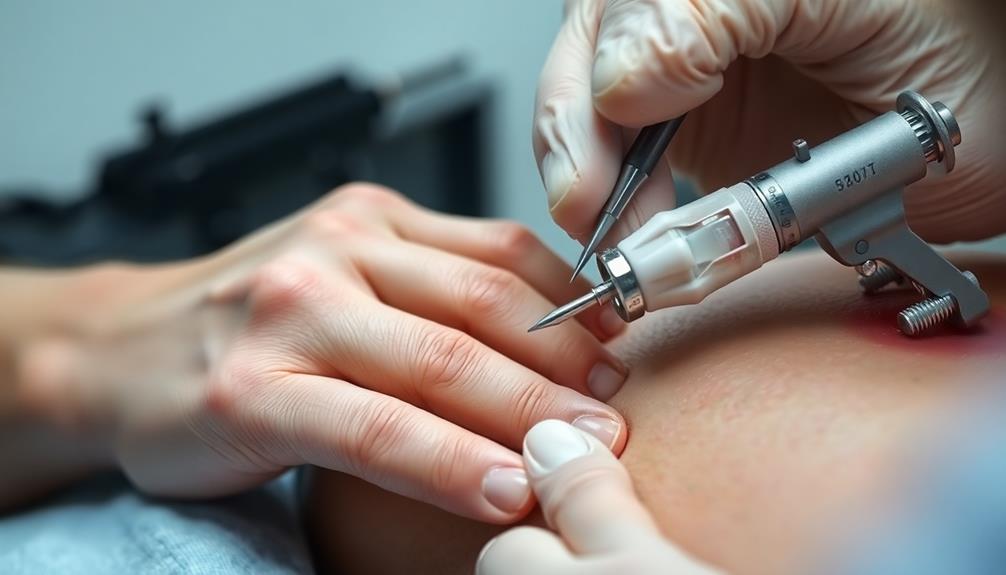
Precision and accuracy are essential factors in the piercing process, and using needles offers significant advantages over piercing guns. When you opt for piercing needles, you're choosing a method that allows for a tailored approach to your anatomy, making it particularly beneficial for body piercings like clitoral hood piercings, which require careful placement for peak results.
This results in cleaner and more accurate piercings, enhancing both the healing process and aesthetic outcome.
Here are some key benefits of using needles:
- Clean Incision: Needles create a precise opening, minimizing trauma to surrounding tissue.
- Controlled Depth: Professional piercers can easily manage how deep the needle goes, reducing complications.
- Exact Placement: Marking the skin before piercing ensures that your jewelry sits perfectly, avoiding uneven piercings.
- Lower Complication Rates: Studies show that needle piercings result in fewer issues during healing compared to the blunt force of guns.
Quality of Jewelry
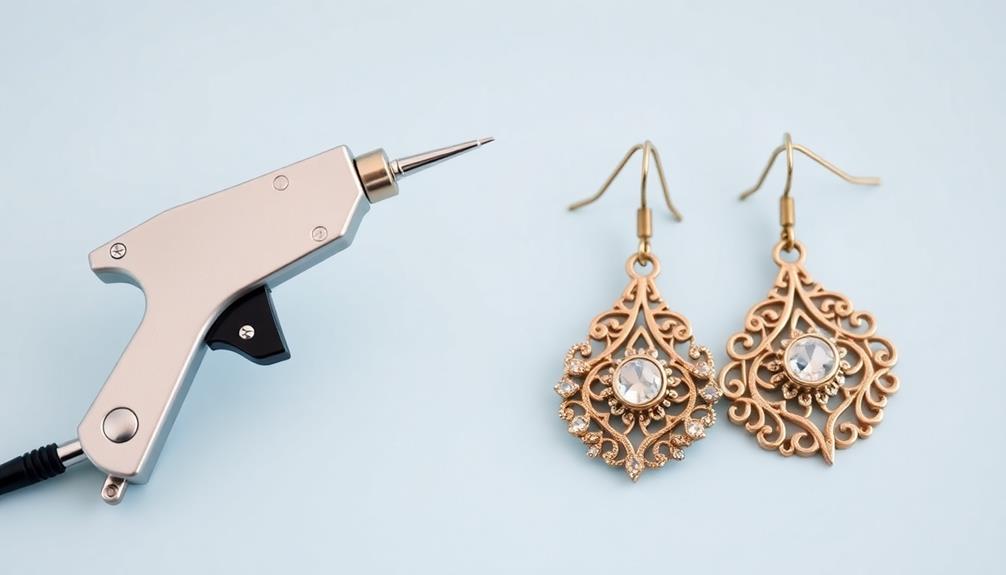
When you choose a professional piercer using needles, you're not just opting for a superior technique; you're also stepping up your jewelry game.
Professional piercers typically offer high-quality jewelry made from implant-grade materials, which greatly reduces the risk of allergic reactions and guarantees durability. In contrast, establishments that use piercing guns often provide lower-quality jewelry, frequently containing cheap materials like nickel, leading to potential skin irritations.
By selecting a needle piercer, you gain access to a wider variety of jewelry styles and colors that cater to diverse fashion preferences. This variety allows you to express your personal style while guaranteeing the safety of your new piercing.
Professional piercers are committed to providing jewelry that meets stringent safety standards, ensuring that all pieces are safe for healing and long-term wear.
Investing in high-quality jewelry from professional piercers not only enhances your overall piercing experience but also contributes to better healing outcomes.
You'll find that the combination of quality materials and expert technique elevates your piercing journey, leading to greater satisfaction and comfort in the long run.
Choose wisely, and your ears (or other body parts) will thank you!
Aftercare Considerations
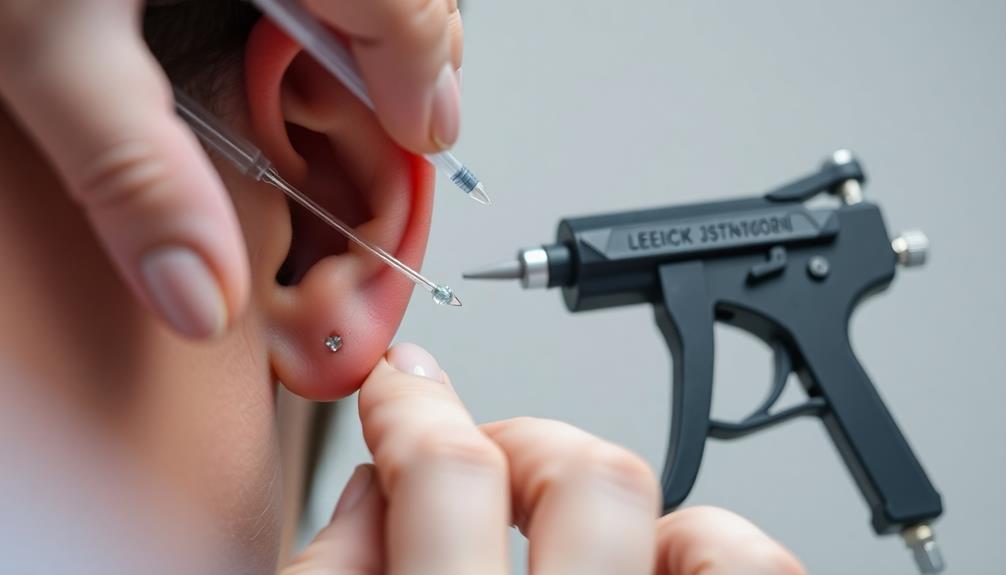
Caring for your new piercing right from the start can make all the difference in achieving ideal healing and preventing infections.
Aftercare is vital, and professional piercers typically provide detailed instructions tailored to your specific piercing. By following these guidelines, you can minimize complications and promote a healthy healing process.
Here are some essential aftercare tips to keep in mind:
- Clean the piercing regularly with saline solution to prevent bacteria buildup.
- Avoid touching the piercing unnecessarily to reduce the risk of irritation and infections.
- Monitor for signs of infection, such as redness, swelling, or unusual discharge.
- Stick to the care routines recommended by your piercer for best results.
Safety and Hygiene Practices
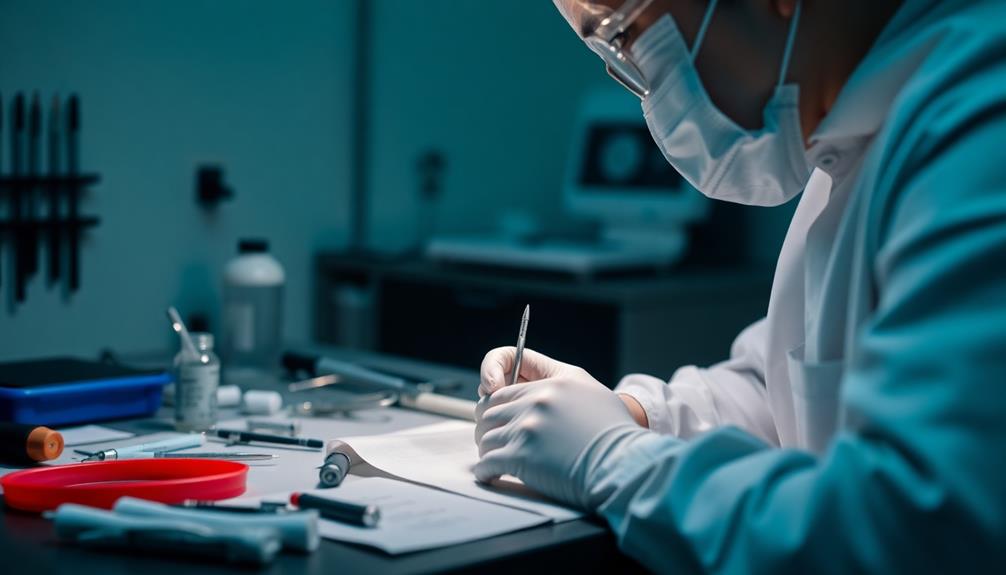
After ensuring proper aftercare for your new piercing, it's equally important to contemplate the safety and hygiene practices surrounding the procedure itself.
Professionals prefer piercing needles over guns due to the enhanced safety and hygiene standards they offer. Piercing needles are single-use and pre-sterilized, greatly reducing the risk of cross-contamination and infection. Unlike piercing guns, which can't be fully sterilized, needles are sterilized in medical-grade autoclaves before each use.
Additionally, understanding proper hamster care principles can emphasize the importance of hygiene in all pet-related procedures.
Using needles results in cleaner incisions, which minimizes tissue damage and scarring. This is vital for promoting faster and more effective healing.
In addition to the tools, the jewelry used also matters. Professionals often opt for implant-grade materials, ensuring safety and minimizing allergic reactions, a standard not always met by establishments using guns.
Evaluating Piercing Professionals
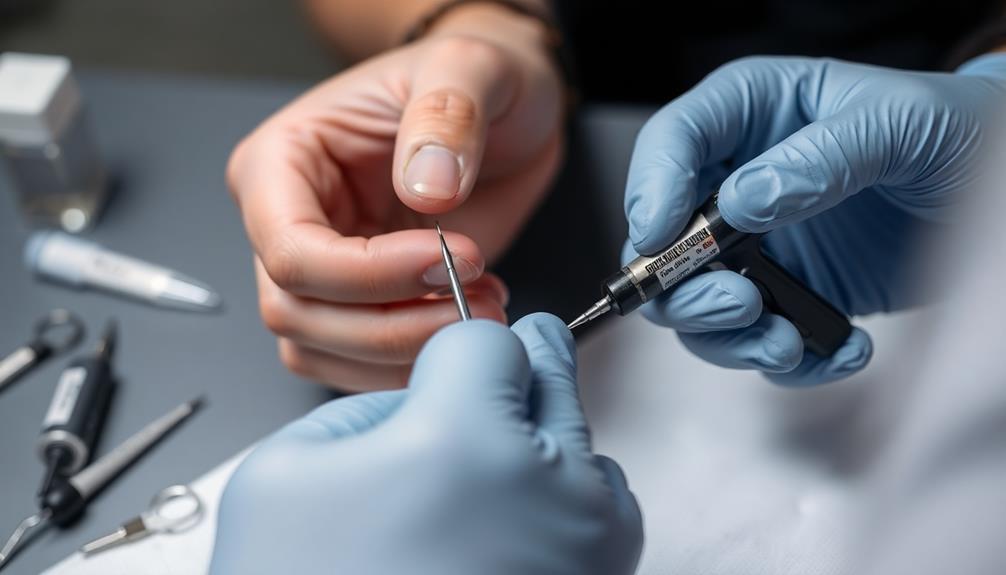
Choosing the right piercing professional can greatly impact your overall experience and the success of your new piercing. It's vital to evaluate potential piercers carefully, especially if you're contemplating using needles instead of guns. Here are some key factors to take into account:
- Training Credentials: Look for piercers associated with reputable organizations like the Association of Professional Piercers, which indicates extensive training in anatomy and safety. This commitment to training can be likened to the importance of effective public speaking training, where skills are honed through practice and feedback.
- Specialization: Choose professional piercers who focus solely on body piercing rather than offering tattoos or other services, as this often reflects a higher level of expertise.
- Consultation: A good piercer will provide a consultation to assess your anatomy and guarantee precise placement, enhancing the overall outcome of your piercing.
- Customer Feedback: Check reviews and testimonials to gauge a piercer's skill level and safety practices. Positive experiences often emphasize satisfaction with healing and aesthetics.
The Future of Piercing Techniques
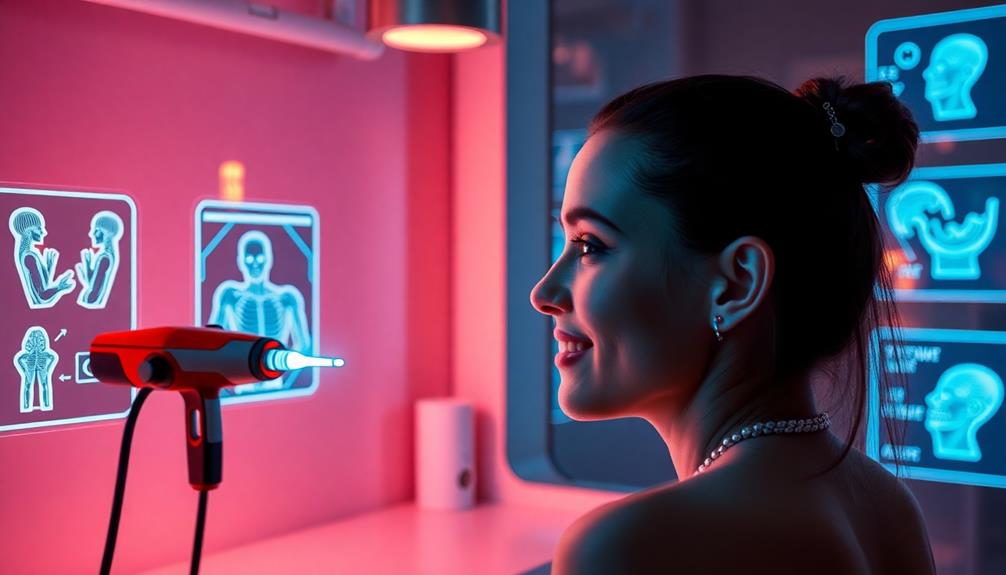
As the piercing industry evolves, professionals are shifting towards techniques that prioritize safety and precision in body art. The future clearly favors single-use, sterilized needles over piercing guns. This change greatly reduces the risk of infection and complications, making needle piercings the preferred choice for many.
Advancements in needle design are enhancing the piercing experience. With longer bevels and specialized coatings, needles are now more comfortable and precise, leading to improved client satisfaction.
As awareness of these benefits grows, professional standards are adapting, emphasizing training in safe use and hygienic practices. This alteration is making needle use the norm across various body piercings.
Additionally, the rise of unique styles and customization is driving demand for trendy techniques that utilize needles. This allows for more artistic expression in body art, catering to individual preferences.
With educational resources and professional guidelines becoming increasingly accessible, clients are empowered to make informed choices about their piercing methods. By prioritizing the advantages of needle piercings over guns, the industry is setting a new standard for quality, safety, and creativity in body art.
Frequently Asked Questions
Why Are Needles Better Than Piercing Guns?
Needles are better because they create cleaner incisions, leading to less pain and quicker healing. They allow for precise placement, reducing complications, and use higher quality jewelry, minimizing allergic reactions and infection risks.
Do Professional Piercers Use Guns?
You might think some professional piercers use guns, but most don't. They prioritize precision and safety, which guns often compromise. By choosing needles, they guarantee a cleaner experience with fewer complications and better healing for you.
Does It Hurt More to Pierce With a Needle or Gun?
When you get pierced with a gun, it often hurts more due to blunt force. Needle piercings usually feel like a quick pinch, causing less trauma and leading to quicker recovery with less overall pain.
Does Claire's Use a Piercing Gun or Needle?
When you walk into Claire's, you'll notice they use a piercing gun for ear piercings. While quick, these guns may cause more pain and longer healing times compared to needle piercings, which professionals recommend.
Conclusion
While you might think piercing guns are quicker and easier, choosing needles offers a more precise and safer experience. Professionals prioritize your comfort and health, using techniques that minimize trauma and guarantee better healing. Investing in a needle piercing not only enhances your look but also supports your well-being. So, next time you're considering a piercing, remember that taking the time to choose the right method can make all the difference in your journey to self-expression.
Hi, my name is Danielle, and I’m an author for piercings-body.com. I have a passion for writing and love to share my knowledge on all things body piercing-related. I’m also a huge advocate for safe body modification practices and believe everyone should be able to make informed decisions about their bodies. When I’m not writing or blogging, I enjoy spending time with my family and friends, practicing yoga, and exploring new places.

